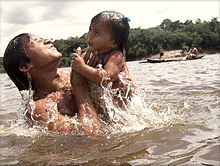Baré people

Baré people in Cuieiras River
|
|
| Regions with significant populations | |
|---|---|
| Amazonas, Brazil (2014) | 11,472 |
| Venezuela (2011) | 5,044 |
| Languages | |
| Baré language, Nheengatu language | |
The Baré, or Hanera, and Werekena are related indigenous people of northwest Brazil and Venezuela. For many years they suffered from violent exploitation by Portuguese and Spanish merchants, forced to work as debt slaves. They moved often to try to avoid the merchants. Today most live by agriculture, hunting, fishing and gathering, and extract piassava fiber for income to buy goods from traders.
The Baré and Werekena people originally spoke the Baré language and Warekena language, both Arawakan languages, but today speak the Nheengatu language, a lingua franca spread by the Carmelites in the colonial period. Some communities of the Upper Xié still speak Warekena. According the Siasi/Sesai, in 2014 there were 11,472 of the Baré people in Amazonas, Brazil. The 2011 national census of Venezuela reported 5,044 Baré people.
Coordinates: 1°20′19″N 67°14′22″W / 1.338682°N 67.239410°W The Baré and Werekena people in Brazil mostly live on the Xié River and the upper reaches of the Rio Negro. Most were forced to move here due to violent contact and exploitation by Europeans. They form the bulk of the population of the Xié River and the upper Rio Negro above the mouth of the Vaupés River. More than 60% of the indigenous people of the Xié are Werekena. The communities downstream from the Cumati waterfall on the Xié are mostly Protestant, influenced by the New Tribes Mission with its base near Vila Nova, near the mouth of the river. Those upstream from the waterfall are mostly Catholic. Both groups still use shamans, prohibited by the missionaries, who follow traditional practices for curing.
...
Wikipedia
